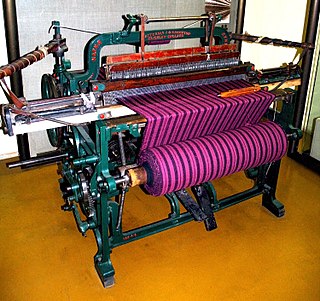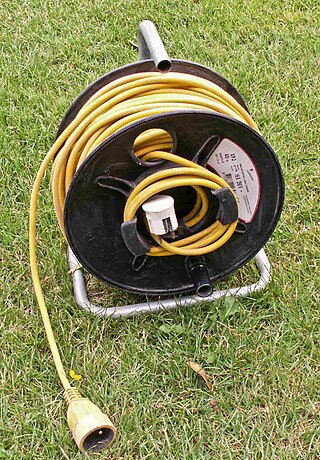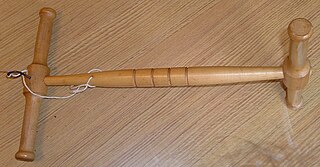Spinning is a twisting technique to form yarn from fibers. The fiber intended is drawn out, twisted, and wound onto a bobbin. A few popular fibers that are spun into yarn other than cotton, which is the most popular, are viscose, animal fibers such as wool, and synthetic polyester. Originally done by hand using a spindle whorl, starting in the 500s AD the spinning wheel became the predominant spinning tool across Asia and Europe. The spinning jenny and spinning mule, invented in the late 1700s, made mechanical spinning far more efficient than spinning by hand, and especially made cotton manufacturing one of the most important industries of the Industrial Revolution.

A loom is a device used to weave cloth and tapestry. The basic purpose of any loom is to hold the warp threads under tension to facilitate the interweaving of the weft threads. The precise shape of the loom and its mechanics may vary, but the basic function is the same.

A spinning wheel is a device for spinning thread or yarn from fibres. It was fundamental to the cotton textile industry prior to the Industrial Revolution. It laid the foundations for later machinery such as the spinning jenny and spinning frame, which displaced the spinning wheel during the Industrial Revolution.

A bobbin or spool is a spindle or cylinder, with or without flanges, on which yarn, thread, wire, tape or film is wound. Bobbins are typically found in industrial textile machinery, as well as in sewing machines, fishing reels, tape measures, film rolls, cassette tapes, within electronic and electrical equipment, and for various other applications.

A reel is a tool used to store elongated and flexible objects by wrapping the material around a cylindrical core known as a spool. Many reels also have flanges around the ends of the spool to help retain the wrapped material and prevent unwanted slippage off the ends. In most cases, the reel spool is hollow in order to pass an axle and allow it to spin like a wheel, a winding process known as reeling, which can be done by manually turning the reel with handles or cranks, or by machine-powered rotating via motors.
In the textile arts, plying is a process of twisting one or more strings of yarn together to create a stronger yarn. Strands are twisted together in the direction opposite that in which they were spun. Plied yarns will not unravel, break, or degrade as easily as unplied yarns. When enough twist is added to the plies to counter the initial twist of each strand, the resulting yarn is "balanced", having no tendency to twist upon itself.

Textile manufacturing or textile engineering is a major industry. It is largely based on the conversion of fibre into yarn, then yarn into fabric. These are then dyed or printed, fabricated into cloth which is then converted into useful goods such as clothing, household items, upholstery and various industrial products.

The spinning mule is a machine used to spin cotton and other fibres. They were used extensively from the late 18th to the early 20th century in the mills of Lancashire and elsewhere. Mules were worked in pairs by a minder, with the help of two boys: the little piecer and the big or side piecer. The carriage carried up to 1,320 spindles and could be 150 feet (46 m) long, and would move forward and back a distance of 5 feet (1.5 m) four times a minute.

A knitting machine is a device used to create knitted fabrics in a semi or fully automated fashion. There are numerous types of knitting machines, ranging from simple spool or board templates with no moving parts to highly complex mechanisms controlled by electronics. All, however, produce various types of knitted fabrics, usually either flat or tubular, and of varying degrees of complexity. Pattern stitches can be selected by hand manipulation of the needles, push-buttons and dials, mechanical punch cards, or electronic pattern reading devices and computers.

Cotton-spinning machinery is machines which process prepared cotton roving into workable yarn or thread. Such machinery can be dated back centuries. During the 18th and 19th centuries, as part of the Industrial Revolution cotton-spinning machinery was developed to bring mass production to the cotton industry. Cotton spinning machinery was installed in large factories, commonly known as cotton mills.

Spinning is an ancient textile art in which plant, animal or synthetic fibres are drawn out and twisted together to form yarn. For thousands of years, fibre was spun by hand using simple tools, the spindle and distaff. After the introduction of the spinning wheel in the 13th century, the output of individual spinners increased dramatically. Mass production later arose in the 18th century with the beginnings of the Industrial Revolution. Hand-spinning remains a popular handicraft.

Spool knitting,loom knitting, corking,French knitting, or tomboy knitting is a form of knitting that uses a spool with a number of nails or pegs around the rim to produce a tube or sheet of fabric. The spool knitting devices are called knitting spools, knitting nancys, knitting frame, knitting loom, or French knitters.

A niddy-noddy is a tool used to make skeins from yarn. It consists of a central bar, with crossbars at each end, offset from each other by 90°. The central bar is generally carved to make it easier to hold. Either one of the crossbars will have a flat edge to allow the skein to slide off, or will be completely removable. Niddy-noddies can be constructed of many different materials including wood, metal, and plastic. Wood is traditional, and most quality niddy-noddies are still made of wood. Budget spinners occasionally use niddy-noddies made from PVC pipes.
Textile manufacturing is one of the oldest human activities. The oldest known textiles date back to about 5000 B.C. In order to make textiles, the first requirement is a source of fibre from which a yarn can be made, primarily by spinning. The yarn is processed by knitting or weaving to create cloth. The machine used for weaving is the loom. Cloth is finished by what are described as wet process to become fabric. The fabric may be dyed, printed or decorated by embroidering with coloured yarns.

Ring spinning is a spindle-based method of spinning fibres, such as cotton, flax or wool, to make a yarn. The ring frame developed from the throstle frame, which in its turn was a descendant of Arkwright's water frame. Ring spinning is a continuous process, unlike mule spinning which uses an intermittent action. In ring spinning, the roving is first attenuated by using drawing rollers, then spun and wound around a rotating spindle which in its turn is contained within an independently rotating ring flyer. Traditionally ring frames could only be used for the coarser counts, but they could be attended by semi-skilled labour.

Bradford Industrial Museum, established 1974 in Moorside Mills, Eccleshill, Bradford, United Kingdom, specializes in relics of local industry, especially printing and textile machinery, kept in working condition for regular demonstrations to the public. There is a Horse Emporium in the old canteen block plus a shop in the mill, and entry is free of charge.

A braiding machine is a device that interlaces three or more strands of yarn or wire to create a variety of materials, including rope, reinforced hose, covered power cords, and some types of lace. Braiding materials include natural and synthetic yarns, metal wires, leather tapes, and others.

A thread is a long strand of material, often composed of several filaments or fibres, used for joining, creating or decorating textiles. Ancient Egyptians were known for creating thread using plant fibers, wool and hair. Today, thread can also be made of many different materials including but not limited to cotton, wool, flax, nylon, silk, polyester etc. There are also metal threads, which can be made of fine wire.

The Leavers machine is a lacemaking machine that John Levers adapted from Heathcoat's Old Loughborough machine. It was made in Nottingham in 1813. The name of the machine was the Leavers machine. The original machine made net but it was discovered that the Jacquard apparatus could be adapted to it. From 1841 lace complete with pattern, net and outline could be made on the Leavers machine.
















